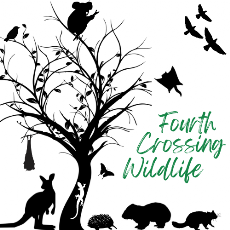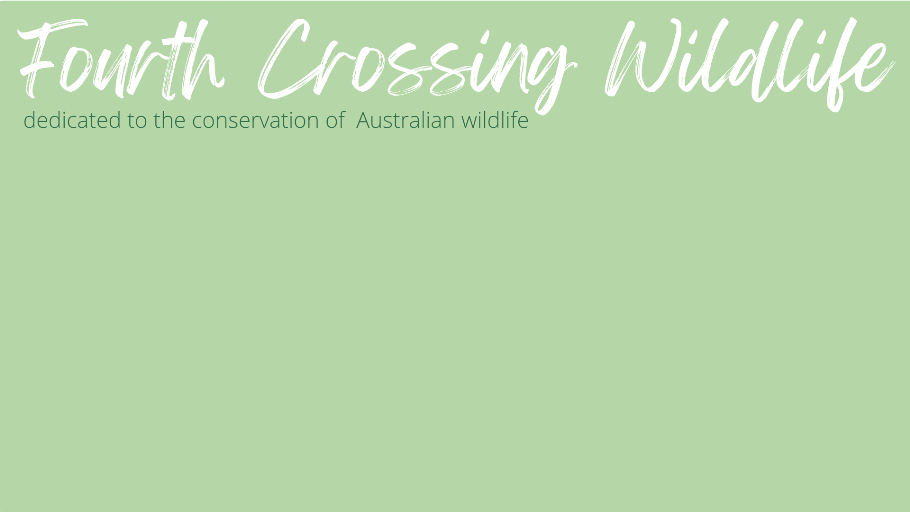Stories
Arnica
by Linda Dennis
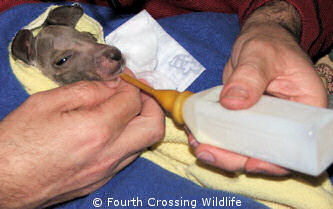 Giving Arnica a bottle was difficult as she refused to drink. We had to gently pulse the bottle so that the milk would dribble into her mouth. 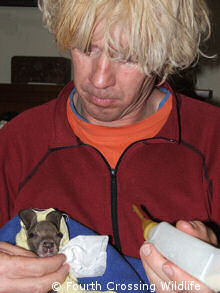 Todd and Arnica 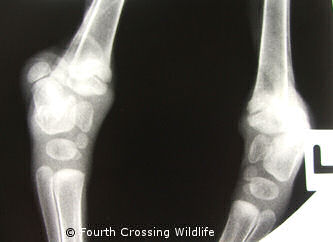 You can clearly see the damage done to the left joint. The bones of the right joint are clearly defined whereas the left joint is a blurred mass, indicating the depth of damage. 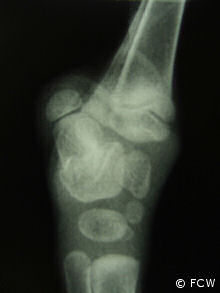 Good joint. 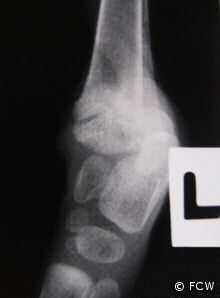 Broken joint. 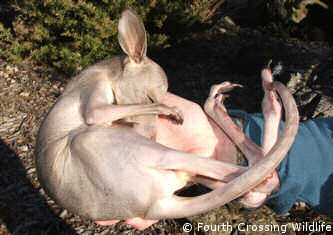 Arnica after she had been put to sleep. Arnica weighed just 850 grams - so tiny she could fit into one hand. 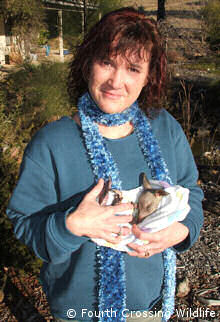 I realised - just before we returned Arnica to the bush - that I hadn't had a photo with her. So, while I battled back the tears, Todd took this photo. Then the tears flowed. It doesn't seem to matter how many are lost, it never gets any easier. 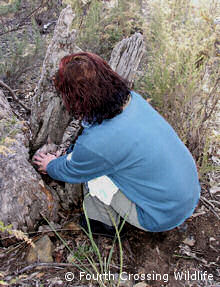 Arnica - back to bush. All the critters that come through our door are returned to the bush - one way or the other. We had a spot on our property, Fourth Crossing, in the middle of a hollowed tree, where we placed the critters that didn't make it. It was a special place for me. | Every once in a while a critter will come into my life for the shortest of times but will touch my heart very deeply. Thump was one. Little Arnica was another. On a cold winters morning, Todd left for work at around 8am only to return home minutes later with a bundle tucked inside his warm jacket. A few kilometre's up the road he had come across a dead female Eastern Grey Kangaroo in the middle of the road. He was rather distraught to realise that many a car had been driven around the old girl and that nobody had spared the time to stop and check her. Todd pulled up alongside the kangaroo so that he could pull her off the road. We both believe there is no dignity for an animal to being left in the middle of the road in a battered and bruised mess. Removing dead animals also stops scavengers such as crows, foxes and eagles from becoming the next road statistic. Before moving the roo Todd leant down to look at the pouch - and it moved. There was life inside! Very gently Todd pulled a tiny joey out of the pouch and very quickly put it inside his jumper to warm it up. He estimated that mum had been hit much earlier that morning or even the night before. The joey was cold, dehydrated and very distressed. When Todd returned home I saw that he had something bundled up inside his jacket and with little words between us my wildlife instincts immediately swung into action. I collected a warm pouch and heat source so that the little roo could be made more comfortable. We quickly assessed the joey for major injuries and saw that it had a very swollen left hock joint and several lacerations to both the legs. We also saw that she was a little girl. Thankfully the cuts were superficial and weren't bleeding so I tucked the joey inside the pouch and put her in my jumper. It was important that she be not be disturbed for an hour or two so that her stress levels could be reduced. Once she had rested and was warm I could do a more thorough assessment and start her on rehydration therapy. Only a week before I had been at the National Wildlife Rehabilitation Conference and listened to Dr Sarah Brett discuss the benefits of providing "Arnica" to injured and distressed native animals. Arnica is a homeopathic treatment used for shock and bruising and Dr Brett sung its praises. I was fascinated by Dr Brett's discussion and decided to call the joey Arnica. I so wished I had some of the homeopathic remedy on me right then and there so that I could help little Arnica calm down and help reduce the likelihood of deep bruising. I could see from the first quick assessment that the bruising was going to be bad. Emails were quickly sent off to the Kimberley Vet Centre in Western Australia - where Dr Brett works - to gather more information on the remedy and to hopefully get some quickly. In the mean time I rang my local vets. I explained the situation and was told that I could give one drop (such a tiny amount!) of pain relief to Arnica. Because she was so young it was dangerous to give any more. After a couple of hours I attempted to assess Arnica more thoroughly. I saw that her left foot bent in a weird way and suspected it was broken but as Arnica was still particularly distressed and wriggled a hell of a lot I halted the assessment and decided to start to rehydrate her instead, giving her warmed Glucodine. She was very difficult to feed and refused to suck on the teat so I very gently pulsed the bottle so that the fluid dribbled into the side of her mouth. I was happy to see that she swallowed the fluid once it was in her mouth. After three lots of rehydration I started Arnica on Di-Vetelact milk replacer to fill her empty belly. I offered her the Di-Vet as it is a very hydrating milk formula and would assist her rehydration. When Todd returned home we assessed her again and found that yes, she had a broken foot. We splinted the area that we thought was broken. The joint looked nasty but we couldn't feel a break so left it unsplinted I then rang my vet Judith Carney for help. Judith told me me to bring Arnica in for x-rays and I was advised to keep up with the pain relief. That night was a bad one. Arnica called all night - calling out of distress, confusion and for her real mum. I got very little sleep and lay awake most of the night with my hand in her pouch, with my fingers enclosing her small face. She slept better that way. Even though she didn't recognise me as her new mum she was comforted by the warmth of my skin - she slept better while I touched her. On the times I did drift off to sleep however and moved away from her she quickly woke me up with another call. The day dawned and although she slept better throughout the second day feeding her was still very difficult as she continued to refuse to suck the teat. I fed her every three hours but only managed to get about five mils of milk into her at a time - even though I sat there for about 45 minutes each time. To make matters worse I was also sick with the flu and felt dreadful. My head was cloudy and my back ached. I felt like I was failing her as my concentration wasn't great. I thought I could that see she was fading in front of my eyes. I realised then it wasn't that she was sleeping better but it was because she was beginning to crash. Todd came home and we changed her to a different milk formula, Biolac, which she seemed to like better. Todd took over feeding duties so that I could rest after such a bad night and because I was so ill. We realised that she was dehydrated again so offered more Glucodine which she took well, but it still wasn't enough. Later in the evening I brought out the big guns - the Hartmans' solutions so that I could give fluids by subcutaneous injection (fluids under the skin). To my horror, when I inserted the needle into the plug of the Hartmans the plug broke and the fluid started to pour out onto the floor! Now unsterile, the fluids could not be used. So we continued with more Glucodine and were thrilled to see that it was working. She became brighter and did the biggest wee! The second night was a good one as she slept the entire night. Finally, she was more content! The third day came about too soon. Off the the vet we went where Arnica was anaesthetised (only lightly as she was young and dehydrated and deeper anaesthesia may have killed her). She was thengiven subcutaneous injection to rehydrate her properly. Judith assessed Arnica and found that the damage was actually in the joint, not in the foot where we had thought. We'd splinted the wrong area! The damage to the foot, and why it looked bent, was tendon damage. My heart sank as I realised that joint breaks were difficult to repair. Judith and I gowned up for x-rays. As I held Arnica the x-rays were taken of both leg joints. Judith was quite concerned with the break - I could tell by the look on her face - but said that there was a chance it could be mended. It did look pretty nasty though, I have to admit. But I kept my hopes high as I knew that more attempts were given to mend native animals these days than in the past where many conditions were seen as irreparable and more animals were euthanased without attempted treatment. Wildlife veterinary care has come along way in recent years. Arnica's leg was then re-splinted and Judith showed me how to place a splint over the foot, joint and leg. Judith supplied me with plastic splints that soften in hot water and can be moulded over a limb (wonderful stuff!), more bandages and a new bag of Hartman's solution! She is an awesome vet who is really keen to help me with my wildlife work. Judith promised that she would contact the vet centre at Western Plains Zoo for more advice and would contact me as soon as she knew more. I left the vet clinic in a mix of hope and despair. At 4pm I received the call..... The news was not good. Judith confirmed her fears that the break was irreparable for an animal that was meant for release back into the wild. Benn Bryant, of Western Plains Zoo, had confirmed this. I was told that if we attempted to mend the bone it would forever be an impediment to her. The joint would be swollen, seized and probably arthritic for the rest of her life. This kind of condition can be controlled if the animal is a pet, but not in an animal that would be returned to the bush. It would slow Arnica down and would make living in the wild a constant struggle and it would probably make her vulnerable to predator attack. For the next hour I struggled to get through work til 5pm when I was to return to the clinic. I was keenly aware of little Arnica resting at my feet in her warm and secure pouch. I collected Todd from work and we made the short trip to the clinic. Judith was waiting for me and with tears streaming down my face Arnica was put to sleep. We drove home in silence and my tears started again when I saw Arnica's mum lying off in the bush. It was time for Arnica to go back to bush. All the critters that come through our door are returned to the bush - one way or the other. We have a spot on our property, in the middle of a hollowed tree, where we place the critters that haven't made it. It's a special place for me and this was Arnica's last resting place. But with considerable distress I realised that I hadn't had a photo with Arnica, so Todd took one for me as I battled the tears. Arnica was with us for such a short time but touched me so deeply. I feel so lucky to be able to do what I do - helping orphaned, injured and sick native animals. |
